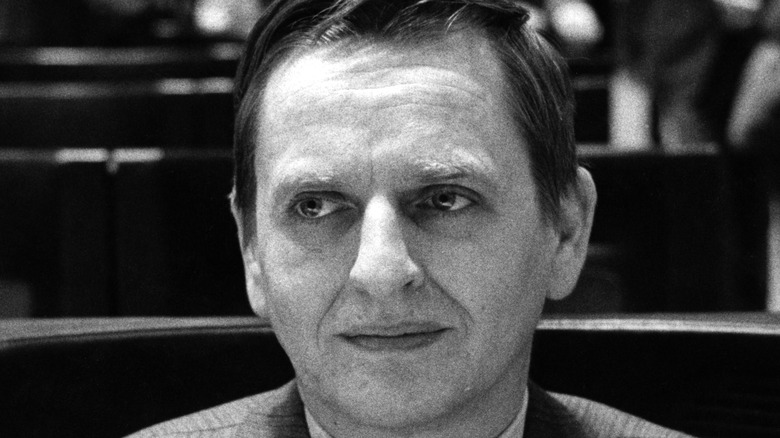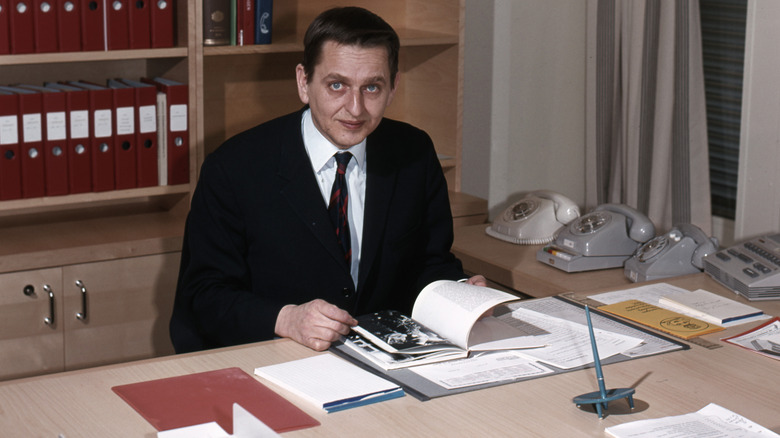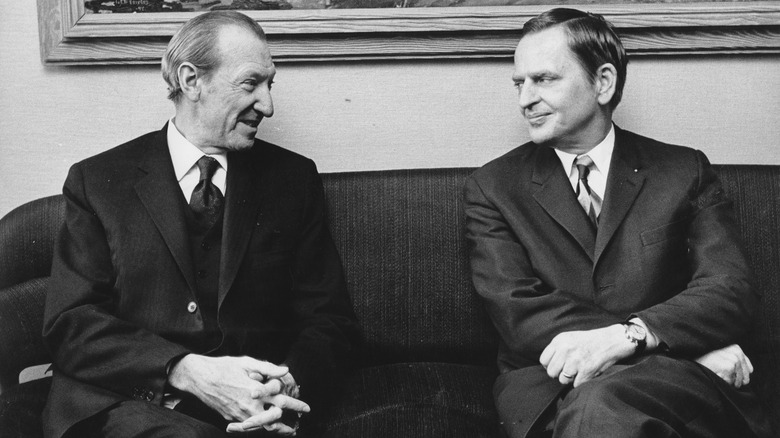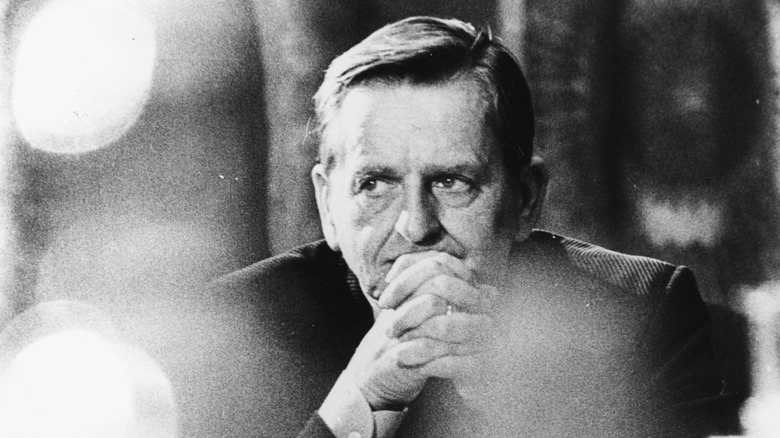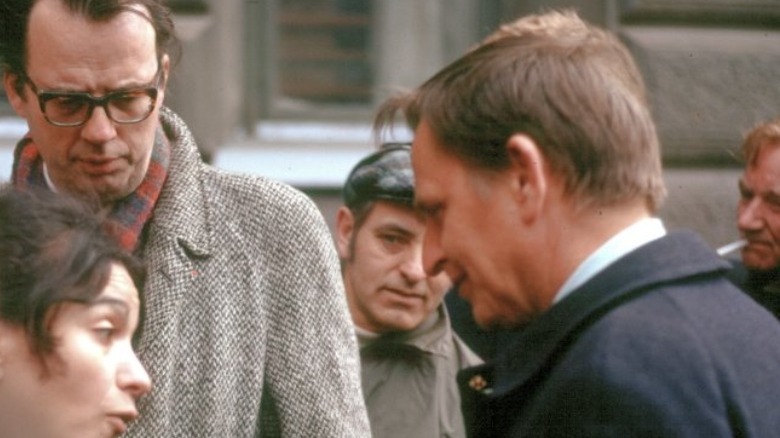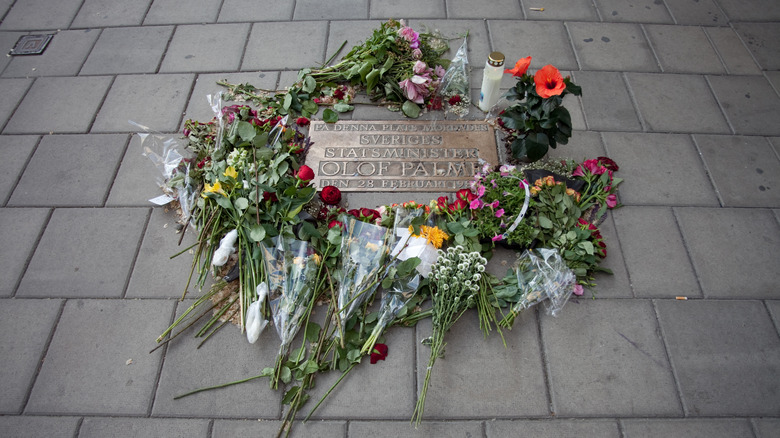The Untold Truth Of Olof Palme's Assassination
On February 28, 1986, Swedish Prime Minster Olof Palme was murdered in the streets of Stockholm after stepping out of the Grand Cinema. He and his wife Lisbet had just seen the comedy "Bröderna Mozart" ("The Mozart Brothers"), as the Library of Congress tells us, and left without any guard detail. It only took one single gunshot, which entered Palme's head and passed straight through. Despite decades of relentless investigation, totaling 90,000 individuals, 10,000 interviewed suspects, 4,000 inspected vehicles, 134 people who personally confessed to the crime, and 29 implicated police officers (figures per CNN), the killer remains at large. Lisbet passed away in 2018 without ever knowing who killed her husband.
For 35 years, Sweden has been haunted by the assassination of Palme in a way similar to the way the assassination of John F. Kennedy haunts the U.S. And just like JFK, Palme's death was a hotbed for endless conspiracy theories and supposedly guilty parties: the militant Kurdistant Worker's Party (PKK), Swedish arms firm Bofors (per the BBC), a staged assassination and still-living Palme somehow related to "family drama" that involved his son Mårten, and the South African government retaliating against Palme's very anti-apartheid stance (per the Library of Congress).
This last point is key to understanding the speculation surrounding Palme's death. Palme was ardently progressive, and opposed not only the South African apartheid (segregation) of black and white people, but the entire Cold War, including the U.S.' involvement in Vietnam, per The New York Times, and practically any violent governmental action worldwide.
A prominent reformer with numerous enemies
To fully understand the circumstances surrounding Palme's death, we've got to understand his policies and the sociopolitical climate of the time. The Olof Palme International Center sums up the beliefs that defined Palme by the time he became secretary to Prime Minister Tage Erlander in 1953: "elimination of colonialism, the right of national self-determination, the need for a new economic world order, the fight against racism, the dream of equal rights and the democratization of education."
Despite growing up upper middle class, Palme was a staunch, impassioned proponent of labor unions and welfare as integral to free, democratic societies. He despised the vein of liberalism that led to the inequities of free-market capitalism, and by the time he took office in 1969, "The Swedish Model" — an economic model that elevated social welfare and healthcare — was already in full force. Palme also pushed heavily for gender equality by building numerous nurseries and pre-schools to allow mothers to re-enter the work force, per the BBC.
Palme condemned the USSR's invasion of Czechoslovakia in 1968, compared the U.S. bombings of North Vietnam to Nazi concentration camps, declared Francisco Franco's fascist regime in Spain "godd*** murderers," and much more. "I don't regret it because in this world you have to speak out fairly loud to make anyone listen," he said in 1971. "I can't keep silent on this issue and won't be pressurized into silence." Such statements made Palme as many enemies as allies.
Murdered along Sweden's busiest street
Palme (above, right, with U.N. Secretary-General Kurt Waldheim) was Prime Minister from 1969-1976, and then 1982-1986, as well as the Leader of the Swedish Social Democratic Party that entire time, from 1969-1986, as the Olof Palme International Center tells us. Even as he made enemies and allies abroad and at home, he often went about without formal security detail in his effort to live "as normal a life as he could," as the BBC says.
On the night of his murder, Palme had taken the subway to the movies with his wife, Lisbet. Lisbet had asked their son Mårten to buy tickets for them, as well as for Mårten and his girlfriend. At 9 p.m. they all met outside the Grand Cinema, and by 11:21 p.m. Olof and Lisbet had left the theater and were waiting at the corner of Sveavägen and Tunnelgatan streets. A man simply walked up behind them, there on "Sweden's busiest road," right in the open, and fired two shots — one at Prime Minister Palme, the other at his wife. The man then "jogged down the road, climbed some stairs to an adjacent street, and disappeared."
Sweden was stupefied. Charlotta Wallsten, 12 at the time, saw it all over the news, "We put on the TV and it was all about his assassination on an open street. The whole country was in shock," continuing, "When he was murdered, the politics that you had weren't the most important thing. It was just shock. This didn't happen in Sweden."
An immense, and bungled, police investigation
As CNN says, forensic analysis of the assassin's bullets — the one that killed Palme, and the other which injured his wife — were conducted at laboratories in Sweden, Germany, and by the FBI in the U.S. They were .357 magnum caliber, but beyond that there wasn't much to tell. Some 35 years later, there's no hope of conclusively matching them to any specific weapon.
"Sweden's largest criminal investigation" and three-decades-long manhunt produced "22,430 different points of interest," including the aforementioned 10,000 interviews. In total, as The New York Times says, there were six full investigations over three separate commissions, but the only person ever charged had his conviction thrown out (more on him later). This led to intense criticism of Swedish authorities. In fact, the case's most promising suspect, Stig Engström, actually offered himself to the police at one point as a witness, but was let go (more on him later, too).
This lack of a conclusive result, along with Palme's political views, resulted in conspiracy after stewing conspiracy. The most popular tale, according to another New York Times report, came in 1990. At the time, police colonel Eugene de Kock, himself convicted of "89 charges ranging from murder to fraud," claimed that a South African spy named Craig Williamson murdered Palme because Palme financially supported the African National Congress (ANC), opponents of the reigning, oppressive white government. However, no evidence supporting this claim, or any other conspiratorial claim, ever panned out.
The most promising suspect committed suicide
In 2018, freelance journalist Thomas Pettersson followed a lead long since gone cold, per The New York Times. Who was Palme's killer? Not the South African government, "mysterious arms dealers," "Kurdish rebels," "Chilean fascists," or the C.I.A. According to Pettersson it was Stig Engström, the aforementioned, common citizen who once offered himself to Swedish authorities as a witness.
At the time of the crime, Engström was 52 years old and "not advancing at his job" at Skandia insurance company. "He didn't get the positions he felt he deserved," Pettersson said, "No family. No prospects in sight. But he also had a drive to be recognized ... To make something great of himself. He enjoyed every second of being in the media." Engström had "the right timing, the right clothing; he has unique information, he lied, he had close access to guns of the right type ... He was right-wing and Palme unfriendly." Submitting himself to the police was perhaps an intentional attempt to throw them off.
As CNN cites, Swedish authorities came to the same conclusion in 2017 after a new evidence review. Engström circulated with like-minded people and was "used to weapons, having served in the military, and belonged to a shooting club." Engström had told the police he was working late on Sveavägen Street the night of the murder, but parts of his story didn't add up. His clothing also matched the killer's. The only problem? He committed suicide in 2000.
Closing the case after 34 years
On June 10, 2020, CNN reported that Swedish authorities decided to close the books on Palme's case, conviction or not. The reasoning is simple: No more good can come out of pursuing it further. Sweden's Chief Prosecutor, Krister Petersson, stated, "My assessment is that, after over 34 years, it is difficult to believe that any further investigation would provide us with any new details and therefore I believe we have come as far as one could expect." As for Stig Engström, the disgruntled insurance company worker and believed assassin? "As the person is deceased," Chief Petersson said, "I cannot bring charges against him and have decided to discontinue the investigation. In my opinion, Stig Engström is the prime suspect."
Chief Petersson went on to criticize law enforcement at the time of Palme's assassination, saying, "Had the current Palme investigation group been in charge 34 years ago, Engström would have been remanded in custody had he been unable to provide satisfactory explanations for his movements and actions. My assessment is that there would have been sufficient evidence to have him detained in custody." The only other potential killer was "petty thief and drug addict" Christer Pettersson (no relation to the police chief) who was convicted in 1988 but had his sentence overturned in 1989 due to "insufficient evidence."
Swedish citizens still visit the spot on Sveavägen where Palme was killed, and his memorial plaque (above).
A film about the Palme murder, "The Unlikely Murderer," begins streaming November 5 on Netflix. The trailer is posted on YouTube.
